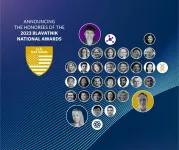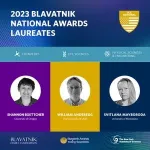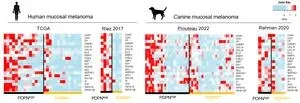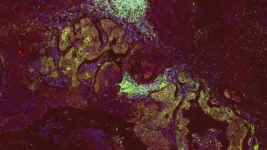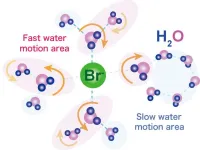Each will receive $250,000, the largest unrestricted scientific award for America’s most innovative, faculty-ranked scientists and engineers who are under the age of 42. The winners and their distinguished research:
2023 Laureate in Life Sciences: William Anderegg, Ph.D., The University of Utah (Ecology & Evolutionary Biology)—Revealing how trees absorb and release carbon dioxide amidst a changing climate
William Anderegg examines the interaction of plant ecology and climate change, from the scale of cells to forest ecosystems. Specifically, he addresses how drought and climate change affect the plant-soil-atmospheric systems, including tree physiology, species interactions, and biosphere-atmosphere feedbacks. His work overturns a 40-year foundational theory on how stomata—pores on leaves that facilitate photosynthesis—behave in order to improve carbon gain and minimize water loss, and in turn, how this affects global forests’ response to climate change. As a leading voice in the field of climate change, Anderegg’s discoveries are already informing climate solutions, global policies, and public health. He is the first ever winner of the Blavatnik Regional Awards to be awarded the Blavatnik National Award.
2023 Laureate in Chemistry: Shannon Boettcher, Ph.D., University of Oregon (Inorganic & Solid-State Chemistry)—Discovering novel methods and materials to harness electrochemistry for sustainability
Shannon Boettcher is creating sustainable, electrochemical methods central to transforming simple mixtures of water and atmospheric gases into fuels, plastics, fertilizers, and other chemicals. Boettcher’s work is grounded in the mechanistic science of understanding electrochemical reactions on the surfaces of electrified solids, particularly under practical conditions where catalysts change in structure and composition. His work builds a foundation for the development of new technologies by addressing key knowledge gaps in understanding and controlling the rates of ion- and electron-transfer across interfaces. Discoveries made in Boettcher’s laboratory are now being applied to improve industrial processes for hydrogen production and carbon capture, establishing him both as a global leader in research and in society’s transition to a green future.
2023 Laureate in Physical Sciences & Engineering: Svitlana Mayboroda, Ph.D., University of Minnesota (Applied Mathematics)—Developed elegant new mathematical theory to understand electronic waves
Svitlana Mayboroda is using applied mathematics to provide physicists with a new fundamental understanding of the behavior of matter at nanometer scales—insights that are relevant for today’s ability to control and manipulate atomic structures. Mayboroda and her collaborators have invented an elegant technique known as localization landscape theory, which solves some long-standing problems in condensed matter physics. This mathematical framework reveals hidden structures that guide the behavior of waves at the atomic level, explaining why waves do not propagate in complex or disordered materials. Mayboroda’s ground-breaking work is leading to improvements in crucial 21st-century technologies like LED lighting, semiconductors, and solar cells.
“I congratulate all the laureates and finalists whose outstanding research gives us hope for the future,” said Len Blavatnik, founder and chairman of Access Industries. He is head of the Blavatnik Family Foundation and a member of the President’s Council of the New York Academy of Sciences.
Nicholas B. Dirks, president and CEO of the New York Academy of Sciences, said, “On behalf of the Academy, we are excited to honor our first laureate who was previously a Regional Award-winner, our first laureate in applied mathematics, and the first laureates from these three public universities. This year’s laureates are working to address major societal challenges—including problems related to energy and sustainability, climate change and forest fires, and transforming solid-state physics and semi-conductor physics—demonstrating the great significance of science for advancing the public good."
The 2023 Blavatnik National Awards received 267 nominations from 134 institutions in 38 U.S. states. Nominees must be faculty-level scientific researchers, 42 years of age or younger.
Three independent juries —one each for life sciences, chemistry, and physical sciences and engineering —were composed of some of America’s most distinguished scientists. The juries selected three winning laureates and 28 finalists.
The Blavatnik National Awards for Young Scientists will celebrate the 2023 laureates and finalists in a ceremony on Sept. 19 at the American Museum of Natural History in New York.
FINALISTS
Life Sciences
Kivanç Birsoy, Ph.D., The Rockefeller University (Molecular & Cellular Biology), developed genetic tools to study mechanisms by which human cells alter their uptake and use of nutrients to adapt to the genetic and environmental stresses observed in disease states such as cancer.
Weizhe Hong, Ph.D., University of California, Los Angeles (Neuroscience), is advancing our understanding of prosocial behavior in animals and how it is regulated by specific neural circuits in the brain. Further, he finds that neural activities between socially interacting animals become correlated, developing a multi-brain framework for social interaction.
Cigall Kadoch, Ph.D., Dana-Farber Cancer Institute & Harvard Medical School (Molecular & Cellular Biology), examines large human genetics studies to identify a group of disease-causing mutations in a multi-protein complex called mSWI/SNF. Kadoch combined biochemistry and genetics to define the structure and function of mSWI/SNF, providing a mechanistic understanding of how mutations can disrupt normal function and cause disease.
Ian Maze, Ph.D., Icahn School of Medicine at Mount Sinai (Neuroscience), is finding that covalent binding of monoamine neurotransmitters to DNA-bound histone proteins informs neural transcriptional plasticity and function. Maze also discovered and characterized numerous brain-enriched chromatin regulatory proteins, which have led to significant improvements in our understanding of, and potential treatments for, neuropsychiatric diseases.
Noah W. Palm, Ph.D., Yale University (Immunology), is developing new approaches to deconvolute the complex interactions between our immune system and gut microbiota: the trillions of microorganisms that colonize and protect the gastrointestinal tract. Palm is transforming these insights into novel strategies to prevent allergies, autoimmunity, and cancer.
Sergiu P. Pașca, M.D., Stanford University (Neuroscience), is pioneering the use of instructive signals to develop three-dimensional cultures of neural tissue known as organoids, and build functioning human neural circuits in preparations he named assembloids. These platforms led to a better understanding of human neural development, and subsequently, potential treatments for brain disorders.
Lei Stanley Qi, Ph.D., Stanford University (Biomedical Engineering & Biotechnology), is making significant developments in CRISPR technologies for gene regulation, epigenome editing, chromatin imaging, and gene therapy. Qi has applied this technology to understand how gene and enhancer networks govern cancer and cell fate determination, and to combat COVID-19.
David Veesler, Ph.D., University of Washington (Immunology), characterized the structure of the SARS-CoV-2 spike protein and identified the ACE2 receptor responsible for the virus’s entry into a cell. His research played a key role in the development of COVID-19 vaccines.
Harris H. Wang, Ph.D., Columbia University (Biomedical Engineering & Biotechnology), developed methods for studying the spatiotemporal organization of a microbiome and editing the metagenome of the microbiome. Using these approaches, Wang mapped the spatial arrangement of microbes in complex communities and programmed them with new functions.
Chemistry
Eric S. Fischer, Ph.D., Dana-Farber Cancer Institute (Chemical Biology), is understanding how small molecules selectively degrade proteins and is converting that knowledge into a road map for new therapeutic interventions.
Danna Freedman, Ph.D., Massachusetts Institute of Technology (Inorganic & Solid-State Chemistry), is elevating molecules to the cutting edge of quantum information technology, having achieved record stability and optical read-out from a molecular quantum bit.
Prashant K. Jain, Ph.D., University of Illinois Urbana-Champaign (Physical Chemistry), is using synchronized vibrations of electrons within nanoparticles to trap light and harness its energy, for sustainable manufacturing of chemicals and zero-carbon fuels such as ammonia and hydrogen.
Jeremiah A. Johnson, Ph.D., Massachusetts Institute of Technology (Polymer Chemistry), is achieving breakthrough control over the synthesis of organic polymers, unlocking real world applications ranging from more easily recycled plastics to the delivery of cancer therapeutics.
Han Li, Ph.D., University of California, Irvine (Chemical Engineering), is creating new tools to control the biochemical reactions in living cells with unparalleled precision, turning cells into bio-factories to manufacture a wide range of useful molecules for food, medicine, or energy.
Garret Miyake, Ph.D., Colorado State University (Polymer Chemistry), is harnessing light in the pursuit of sustainability, from discovering new light-driven reactions of molecules and polymers in order to creating coatings that can reduce energy needs by making windows more heat reflective.
Alison Narayan, Ph.D., University of Michigan (Organic Chemistry), is pioneering the use of protein engineering tools to uncover new bio-catalyzed reactions for synthesis of complex molecules used in therapies or drugs.
Kerri A. Pratt, Ph.D., University of Michigan (Environmental Chemistry & Geochemistry), uses novel measurement techniques to redefine our understanding of the chemical interactions in the atmosphere of Arctic and urban winter environments, tackling the global challenges of climate change and air quality.
Yogesh Surendranath, Ph.D., Massachusetts Institute of Technology (Inorganic & Solid-State Chemistry), is transforming the field of electrochemistry with his development of tunable graphite-based catalysts, which he is using to reveal new molecular-level insights into electrochemical reaction mechanisms.
Physical Sciences & Engineering
Kaushik Chowdhury, Ph.D., Northeastern University (Electrical Engineering), is addressing the global need of telecommunications spectrum scarcity, as well as improve connectivity by designing next generation wireless systems and machine learning-based network operations.
Ivan Z. Corwin, Ph.D., Columbia University (Applied Mathematics), is developing probabilistic mathematical models of interacting particle systems. Such models are important for understanding phenomena as diverse as crystal growth, traffic flow, noisy data, and the spread of disease within a population.
Jennifer A. Dionne, Ph.D., Stanford University (Materials Science & Nanotechnology), is pioneering the development of new imaging techniques that enable direct visualization of chemical and biological processes in real time, and with nano-to-atomic scale spatial resolution.
Asegun Henry, Ph.D., Massachusetts Institute of Technology (Mechanical & Aeronautical Engineering),
is creating sustainable energy technologies, including ultra-low-cost and efficient grid-scale energy storage systems utilizing high-temperature liquid metals as heat transfer fluids.
Shirley Ho, Ph.D., Flatiron Institute (Astrophysics & Cosmology), is translating what deep neural networks have learned from computational simulations and astronomical data into astrophysical insights through a combination of deep learning and other statistical techniques.
Patrick E. Hopkins, Ph.D., University of Virginia (Mechanical & Aeronautical Engineering), is revolutionizing the design of materials to create energy-efficient devices, including ultrahigh and ultralow thermal conductivity materials, dynamically tunable thermal switches that operate like light bulbs, and thermal diodes that couple heat, light and charge.
Maryam M. Shanechi, Ph.D., University of Southern California (Electrical Engineering), is pioneering brain-machine interfaces that can model, decode, and control complex neural activity patterns by the intersection of engineering, computing, and neuroscience.
Jessica K. Werk, Ph.D., University of Washington (Astrophysics & Cosmology), is working with both astrophysical observations and simulations to build a comprehensive theory of galaxy evolution that includes the physics of their gaseous atmospheres—key structures that can fuel star formation for billions of years.
Sheng Xu, Ph.D., University of California San Diego (Materials Science & Nanotechnology), is advancing wearable electronics with integrated deep-tissue sensors, multilayered configurations, and novel photovoltaic power sources, enabling continuous-monitoring technology for future healthcare.
Guihua Yu, Ph.D., The University of Texas at Austin (Materials Science & Nanotechnology), is addressing energy and environmental challenges with innovative nanomaterials called “energy gels,” with wide-ranging applications from fast-charging batteries and electrocatalysts, to seawater desalinization and solar-powered water-harvesters for sustainable agriculture.
About the Blavatnik National Awards for Young Scientists
The Blavatnik Awards for Young Scientists, established by the Blavatnik Family Foundation in 2007 and independently administered by the New York Academy of Sciences, began by identifying outstanding scientific talent in New York, New Jersey, and Connecticut. In 2014, the Blavatnik National Awards were created to recognize faculty-rank scientists throughout the United States. In 2017, the Awards were further expanded to honor faculty-rank scientists in the United Kingdom and Israel. For updates about the Blavatnik Awards for Young Scientists, please visit www.blavatnikawards.org or follow us on Twitter and Facebook @BlavatnikAwards.
About the Blavatnik Family Foundation
The Blavatnik Family Foundation supports world-renowned educational, scientific, cultural, and charitable institutions in the United States, the United Kingdom, Israel, and across the globe. Led by Len Blavatnik, founder and chairman of Access Industries, the Foundation advances and promotes innovation, discovery, and creativity to benefit the whole of society. Over the past decade, the Foundation has contributed more than $1 billion to over 250 organizations. See more at www.blavatnikfoundation.org
About the New York Academy of Sciences
The New York Academy of Sciences is an independent, not-for-profit organization that since 1817 has been committed to advancing science for the benefit of society. With more than 20,000 Members in 100 countries, the Academy advances scientific and technical knowledge, addresses global challenges with science-based solutions, and sponsors a wide variety of educational initiatives at all levels for STEM and STEM-related fields. The Academy hosts programs and publishes content in the life and physical sciences, the social sciences, nutrition, artificial intelligence, computer science, and sustainability. The Academy also provides professional and educational resources for researchers across all phases of their careers. Please visit us online at www.nyas.org.
Media contact
Kamala Murthy, kmurthy@nyas.org, +1 (347) 526-8480
END
